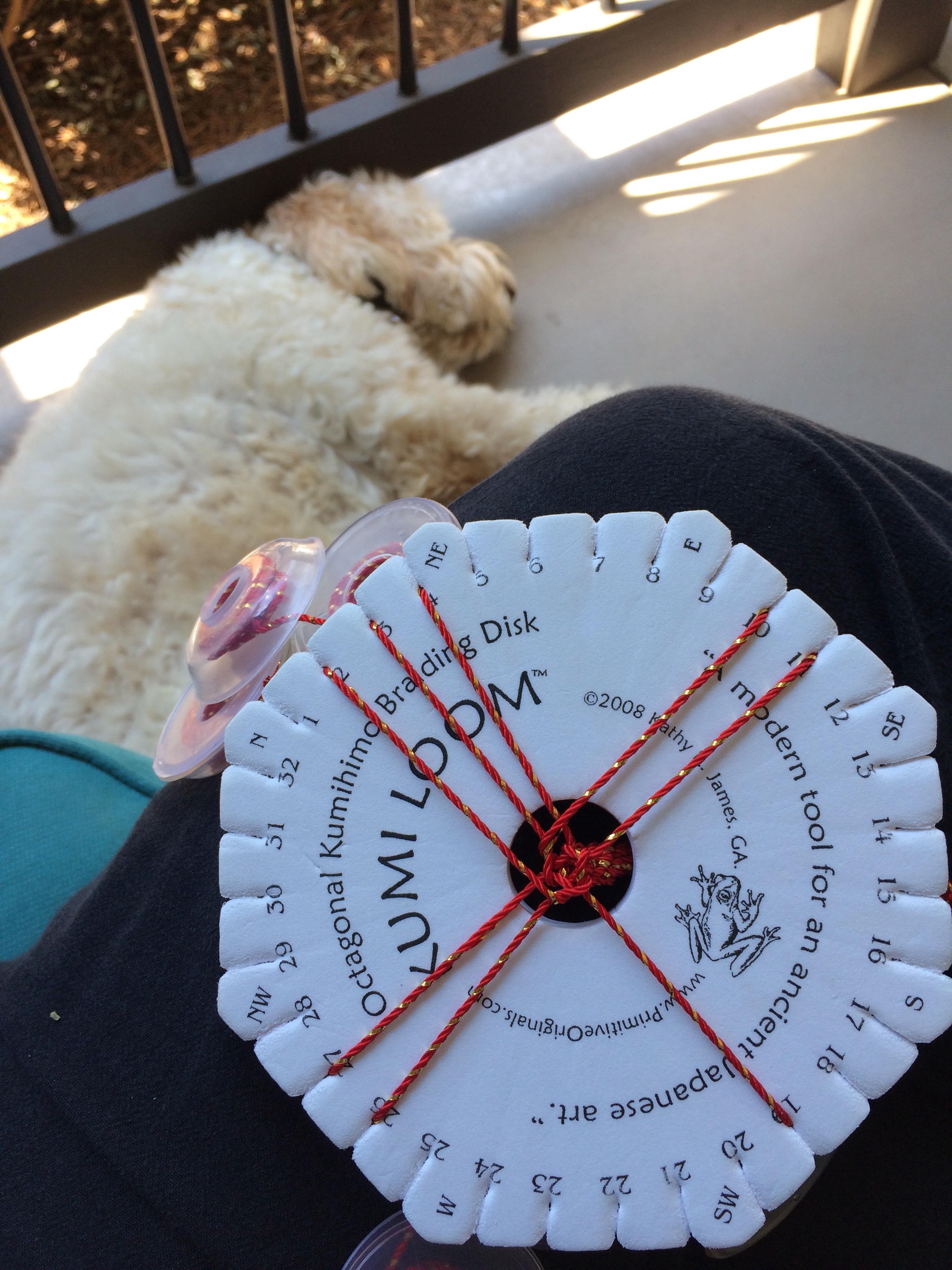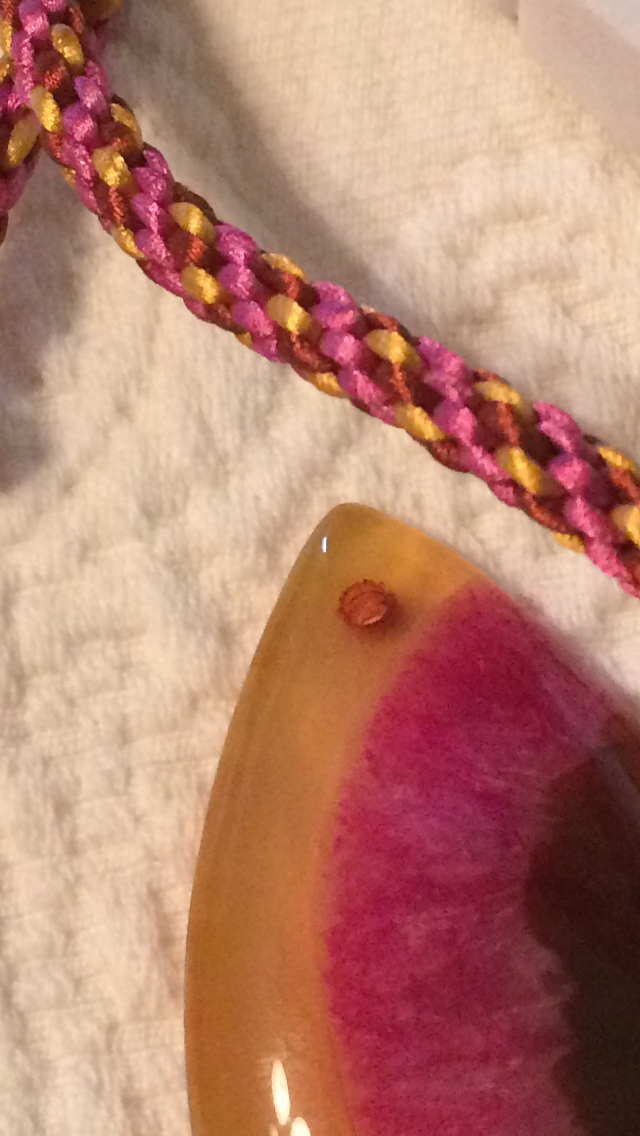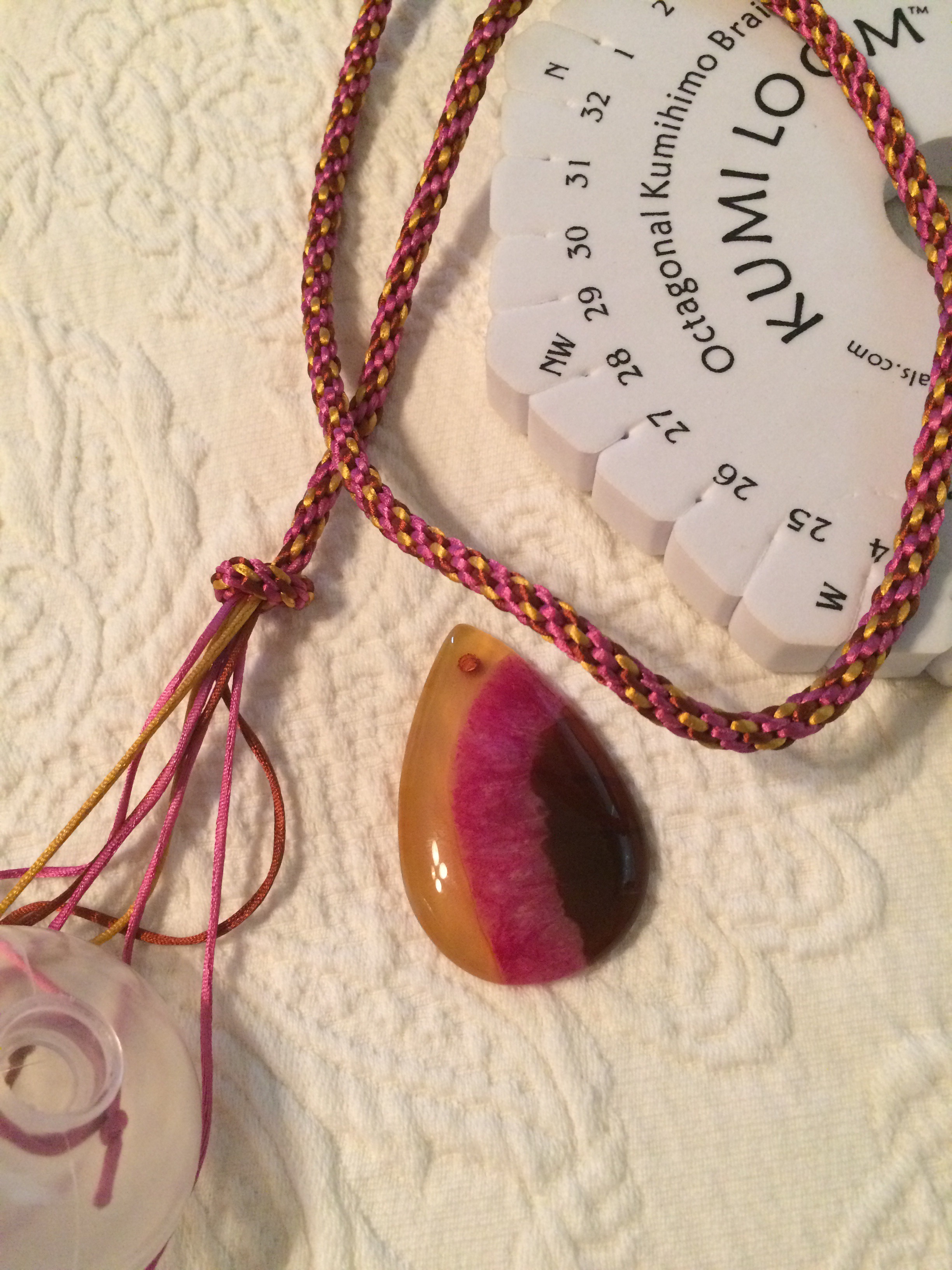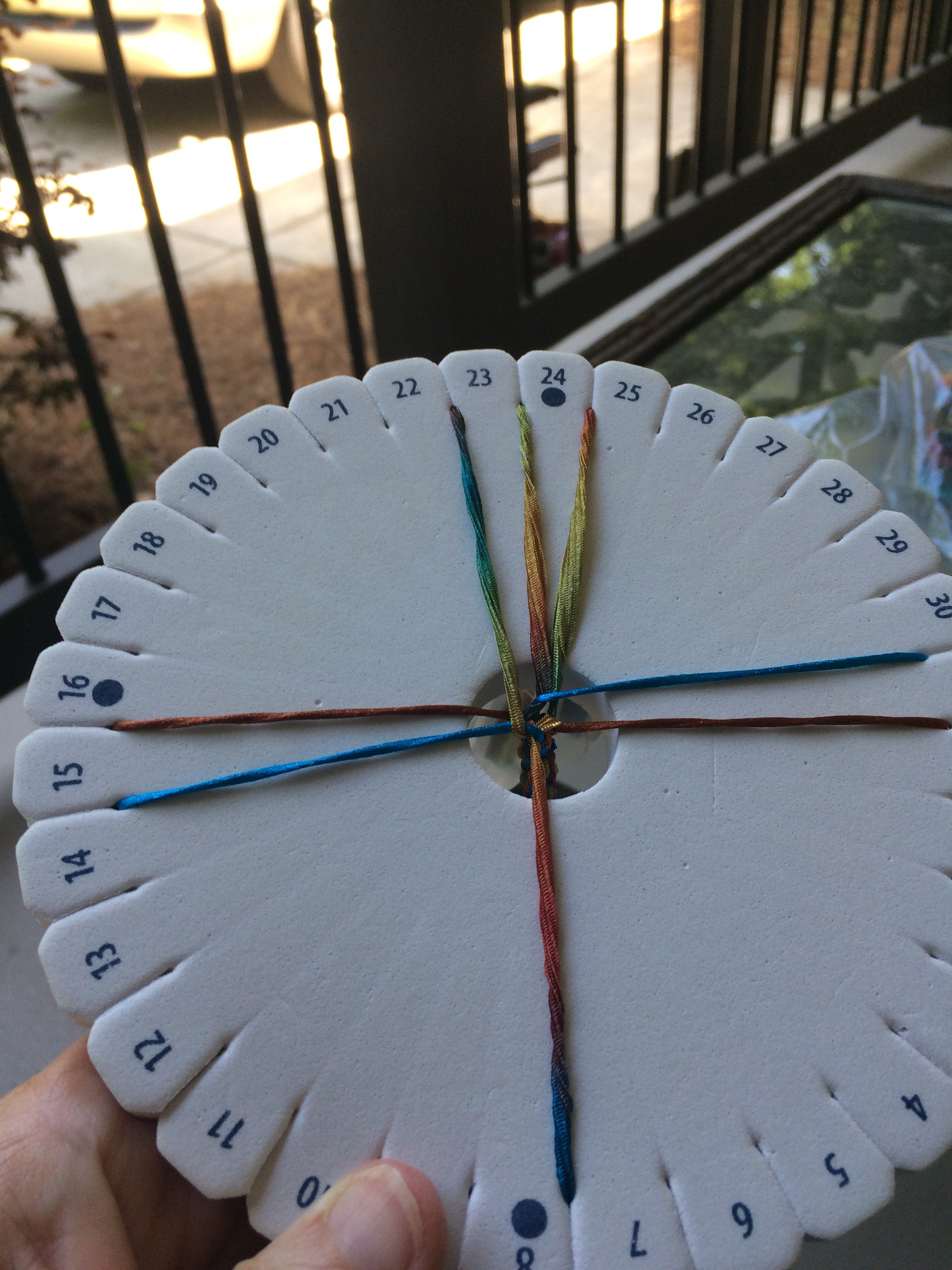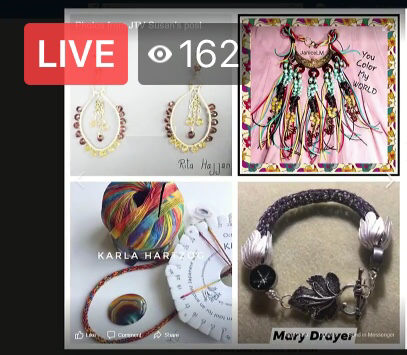 Susan Thomas showed my work on The Circle on her show on JTV Extra today. She shows everyone’s work who submits, now, but it’s still an honor and a thrill. Today’s theme was Color Crush, and I shared one of my favorite yarns for kumihimo, “Copper Penny,” with a work in progress.
Susan Thomas showed my work on The Circle on her show on JTV Extra today. She shows everyone’s work who submits, now, but it’s still an honor and a thrill. Today’s theme was Color Crush, and I shared one of my favorite yarns for kumihimo, “Copper Penny,” with a work in progress.
Tag Archives: Kumihimo
Tassels!
I think I’m on to something adding tassels to my Asian inspired necklaces!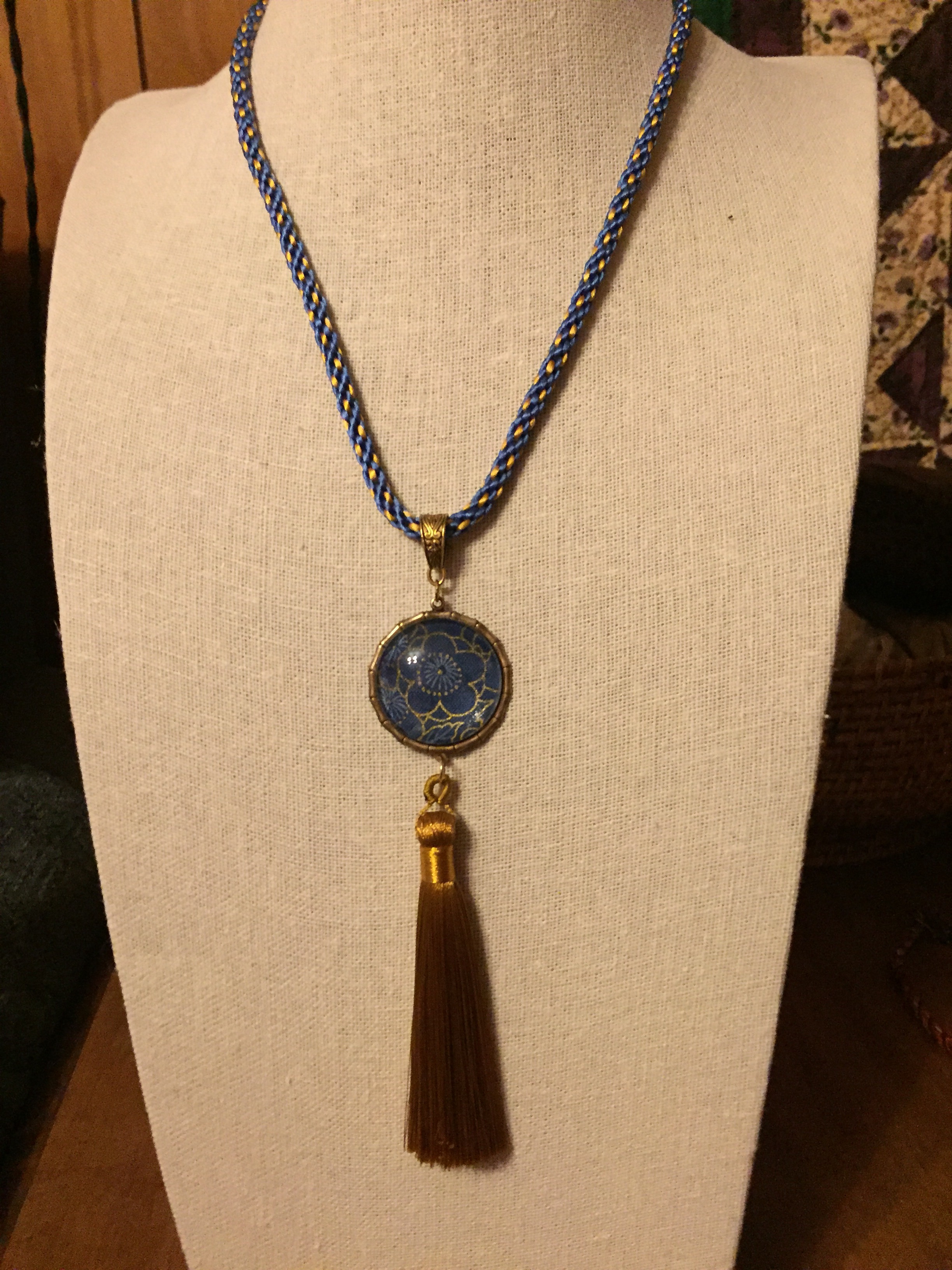
I found little brass blanks I can use to add a pendant loop to the back of my bamboo edged pendant frames: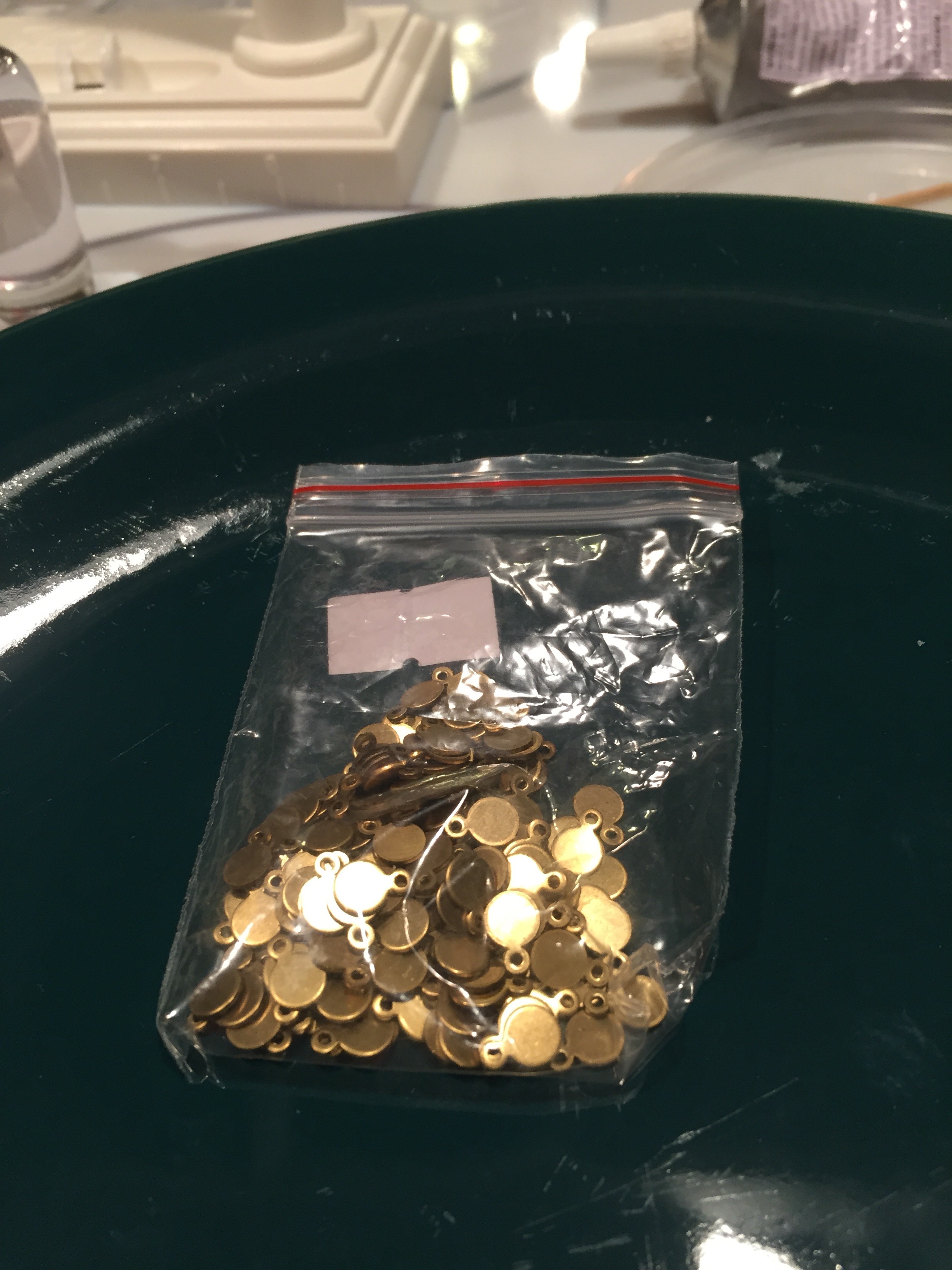
A little E6000 and a little dry time: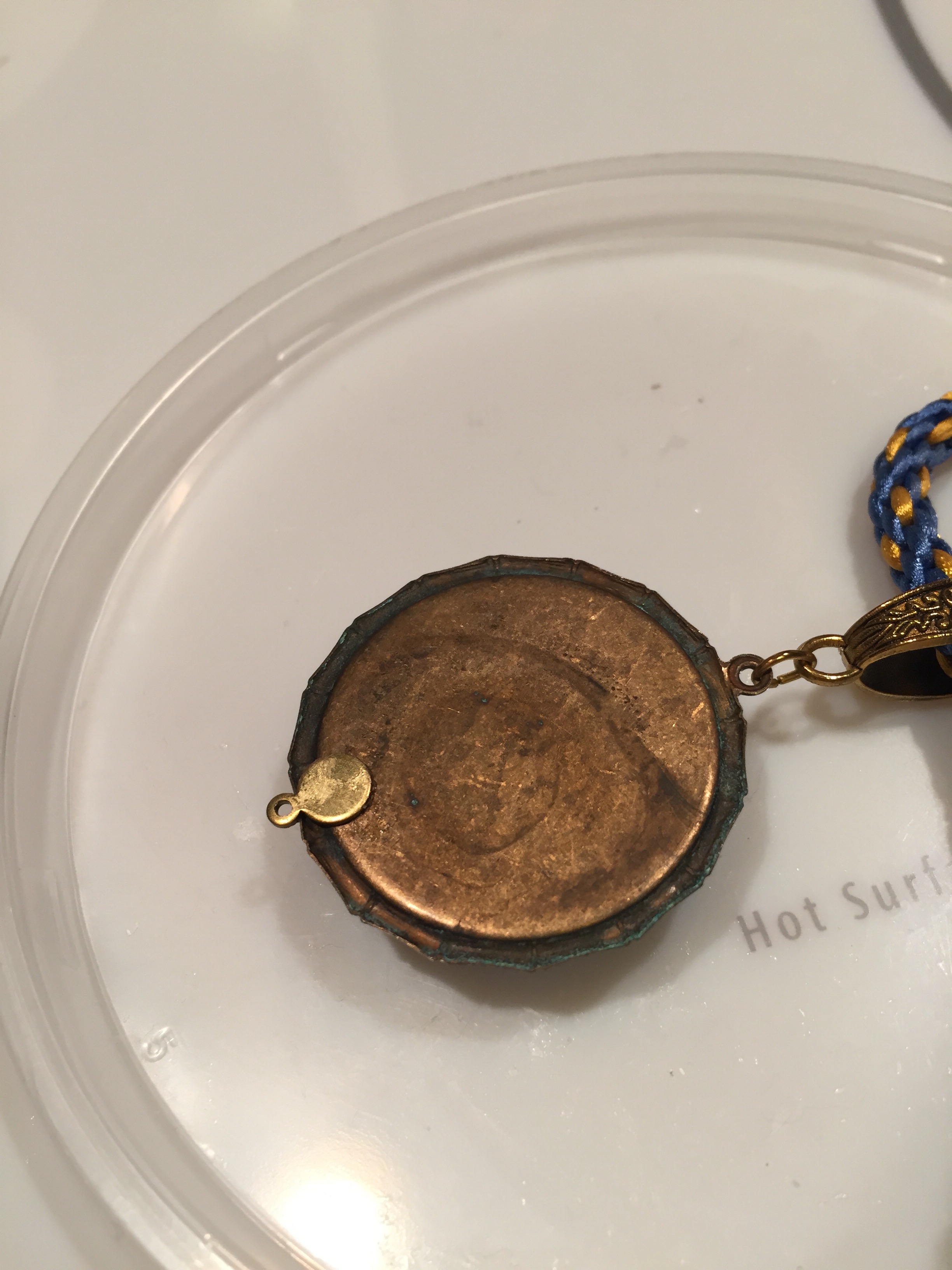
A tassel and a jump ring and I’m in business!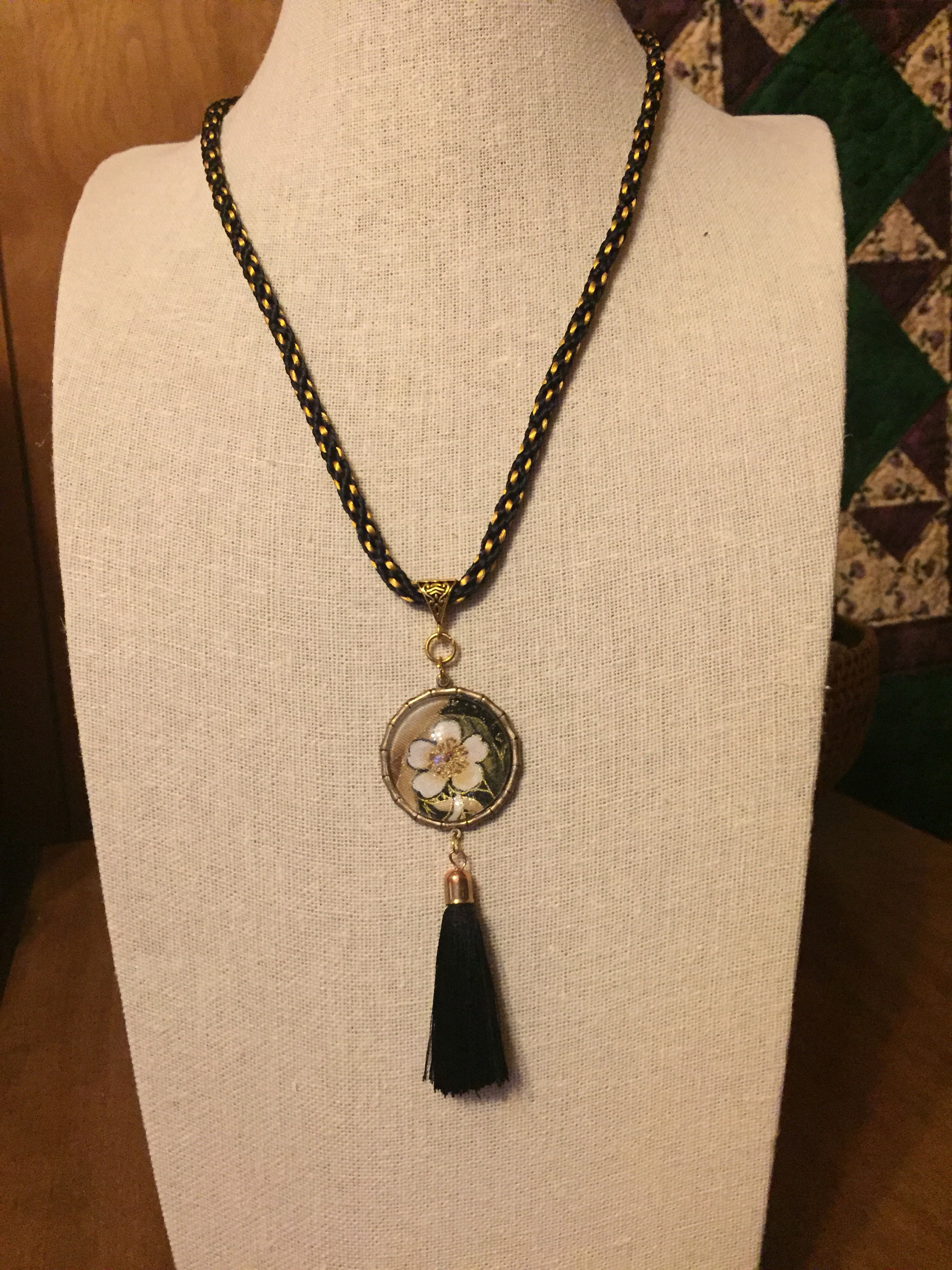
The black tassel is by Bead Landing via Michael’s. The gold one is from a supplier I found on eBay. I will have to favorite them, because it is beautiful and was nicely packaged.
The black and gold necklace is in my shop. So is the blue, but I’ll need to update it! (Since I just did!)
Basic Kumihimo Tutorial, Part 1, Loading the disc…
I told some friends I would put together a kumihimo tutorial, so here goes: I’m using a basic round Beadsmith kumihimo disk for this tutorial, but I’m turning it upside down.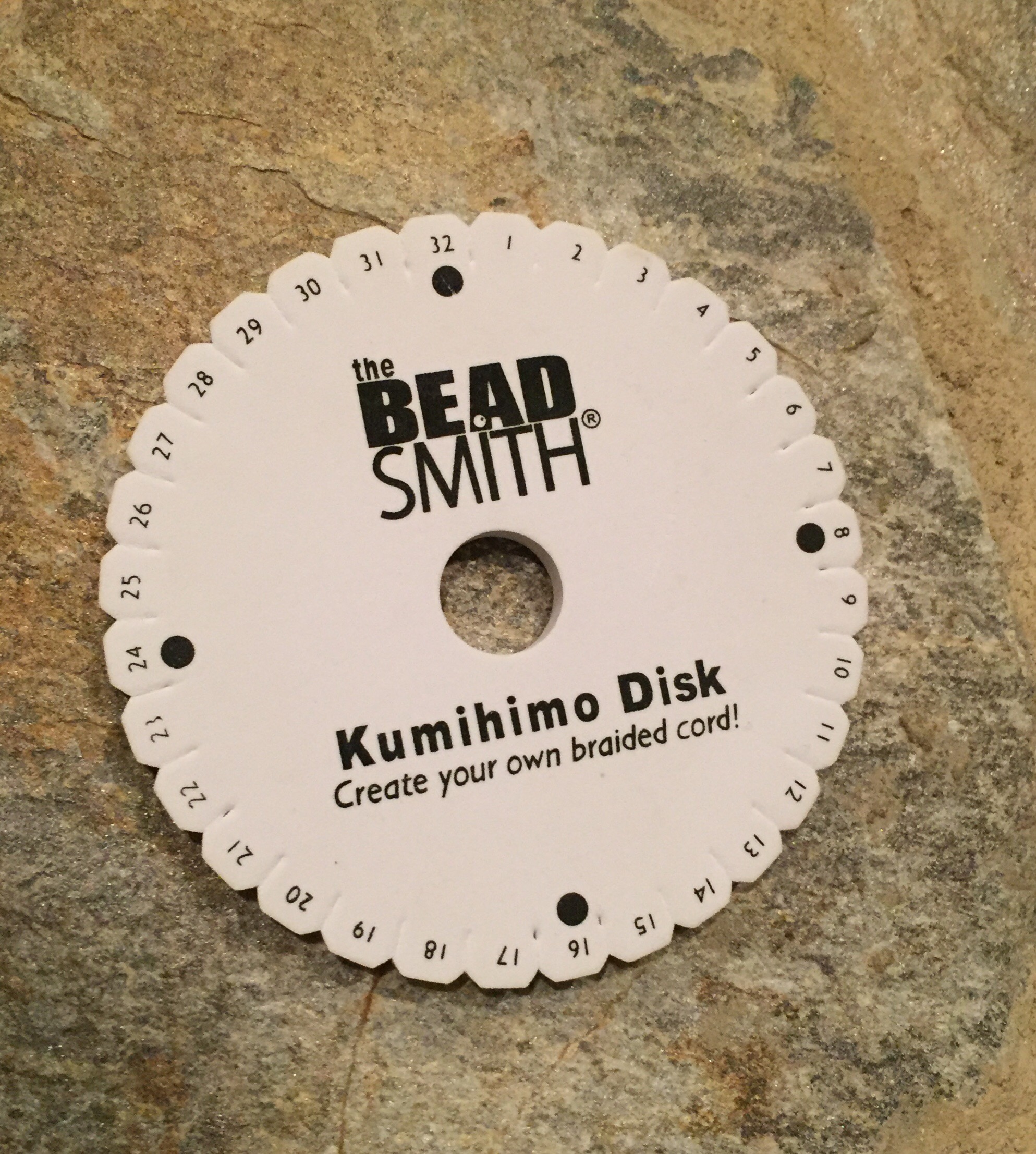
The back of this disc is blank, and I’m using this side to show you there is no need for dots or letters or numbers to confuse you. For this tutorial, the blank side of the disk is the top, and the printed side is the bottom or back or underside.
For this tutorial, the blank side of the disk is the top, and the printed side is the bottom or back or underside.
The braid I’m going to teach you is the basic 8 strand or cord or warp braid. It has a lovely Japanese name, but it was all I could do to learn to say kumihimo! (Coo-me-HE-mo)
Begin by cutting three foot, or one meter, lengths of 8 cords. Any variety of cords or fibers can be used. For teaching purposes, I chose 8 different colors of mouse tail (1mm satin cord. The larger 2mm cord is often called rat tail.) The tiny little knot at the end of each cord is not necessary, it’s just something I do to keep the mouse tail from getting, “ratty!” If you use a cord or fiber that ravels, tie the tiny knots!
The tiny little knot at the end of each cord is not necessary, it’s just something I do to keep the mouse tail from getting, “ratty!” If you use a cord or fiber that ravels, tie the tiny knots!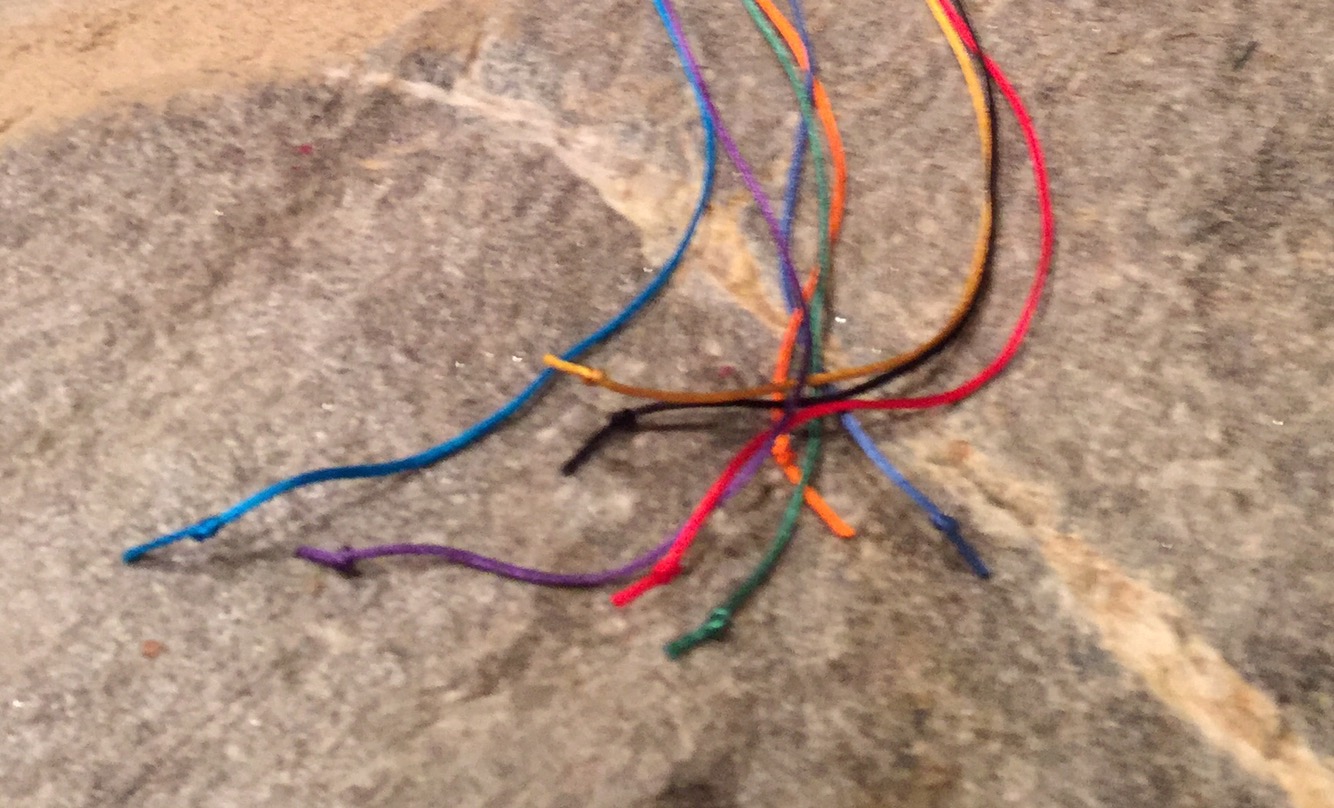 Hold one end of all 8 cords together and tie them together with an overhand knot.
Hold one end of all 8 cords together and tie them together with an overhand knot. Push the knot through the center hole of the disk.
Push the knot through the center hole of the disk.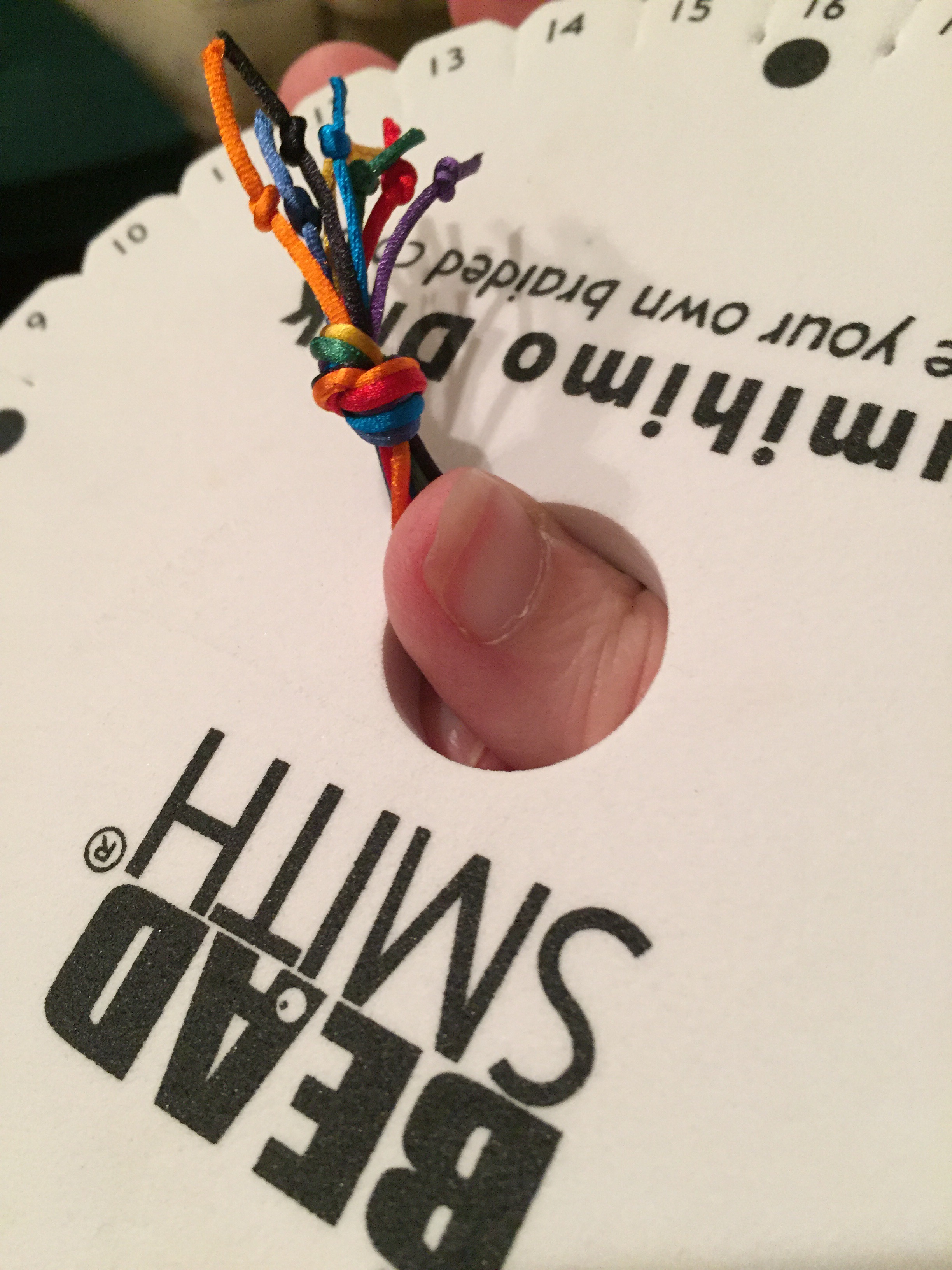 The knot should now be on the back side.
The knot should now be on the back side. 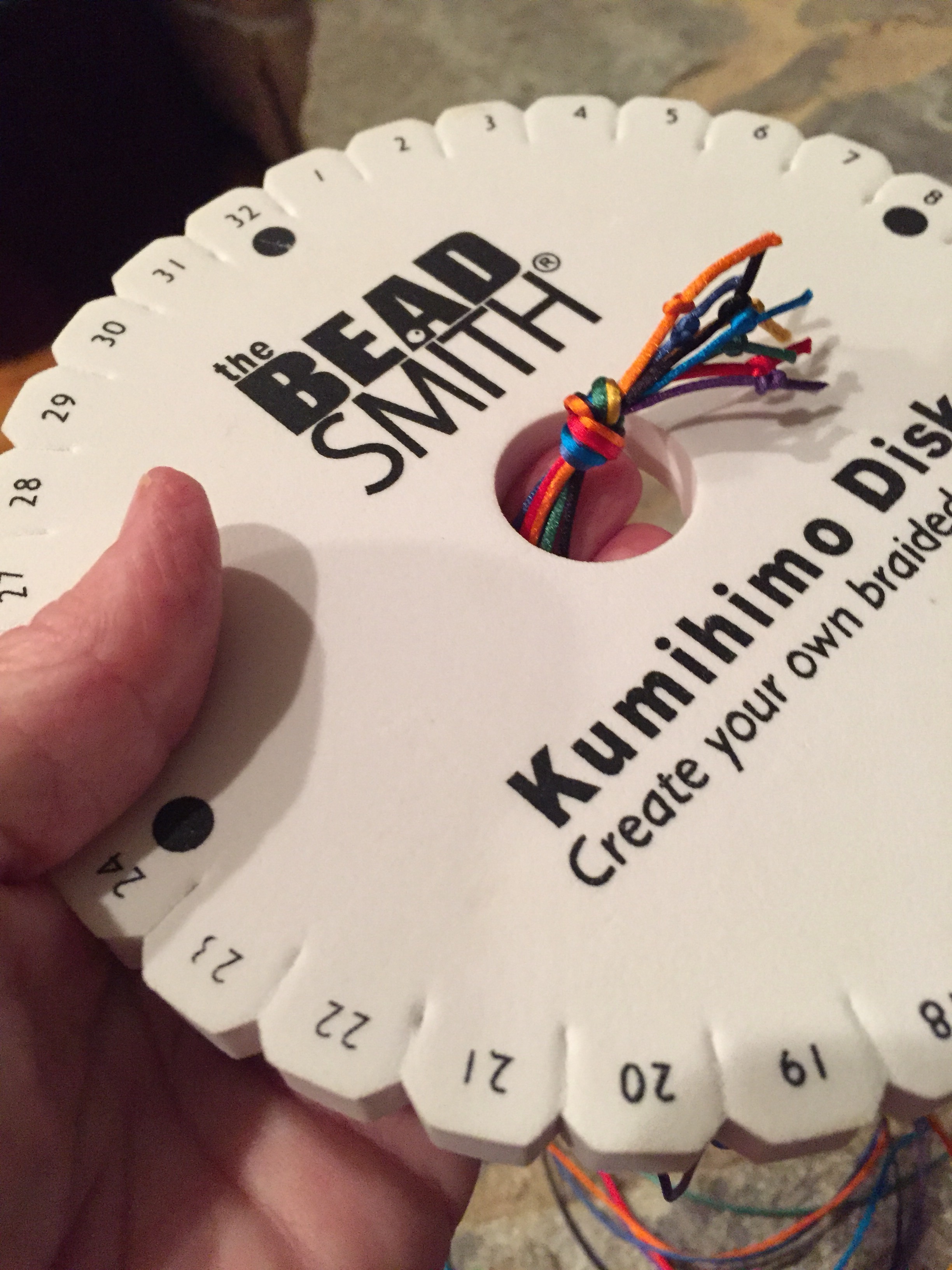
On the top of the disk, arrange the 8 cords , two at a time, in a “+” formation as pictured below. 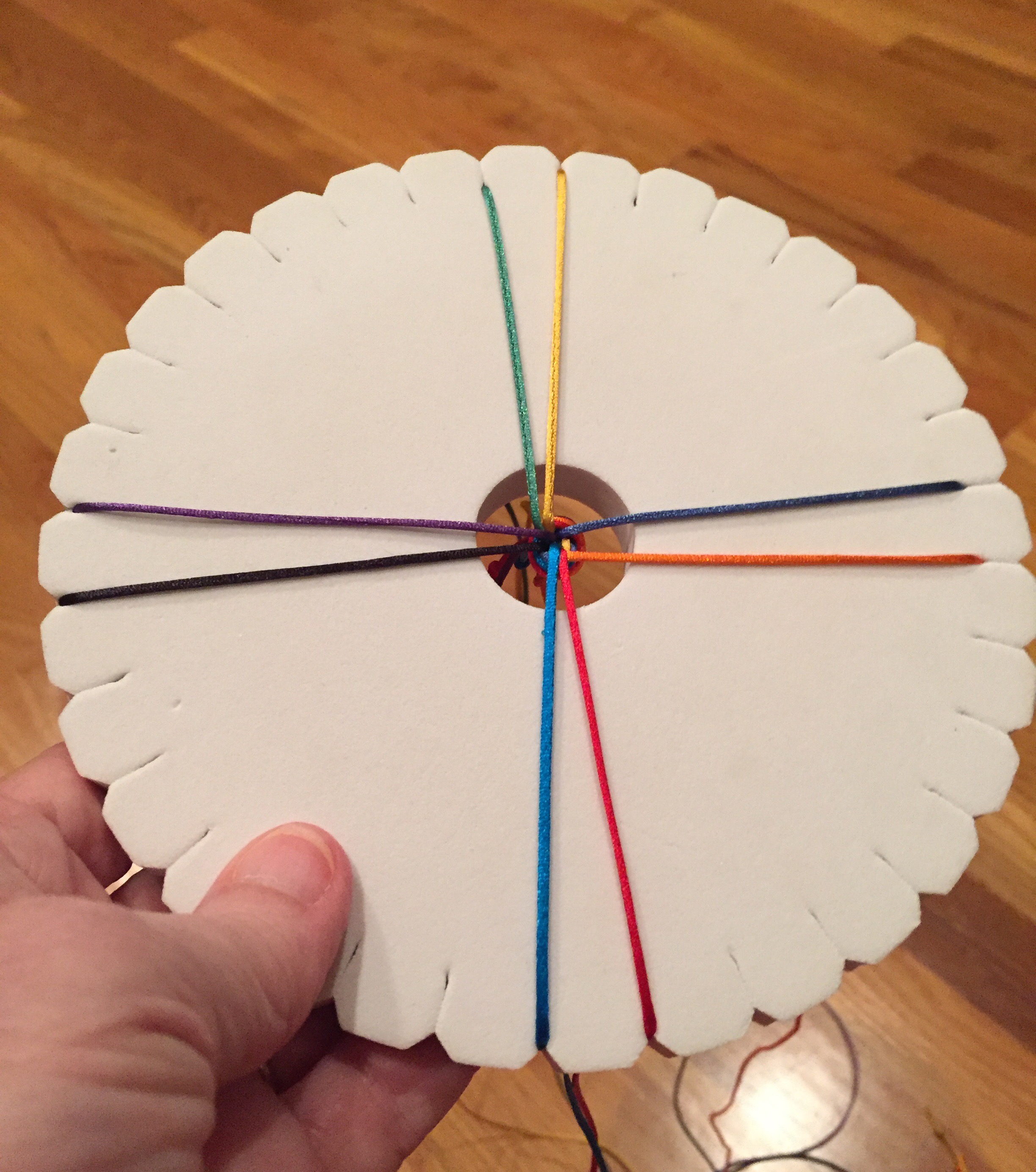 The knot stays in the center hole and each cord is tucked into a slot in the disk in the “+” formation. Notice that the cords are in pairs. The members of each pair are in slots next to each other.
The knot stays in the center hole and each cord is tucked into a slot in the disk in the “+” formation. Notice that the cords are in pairs. The members of each pair are in slots next to each other.
This is how the “back,” or, “underside,” of the disk should look: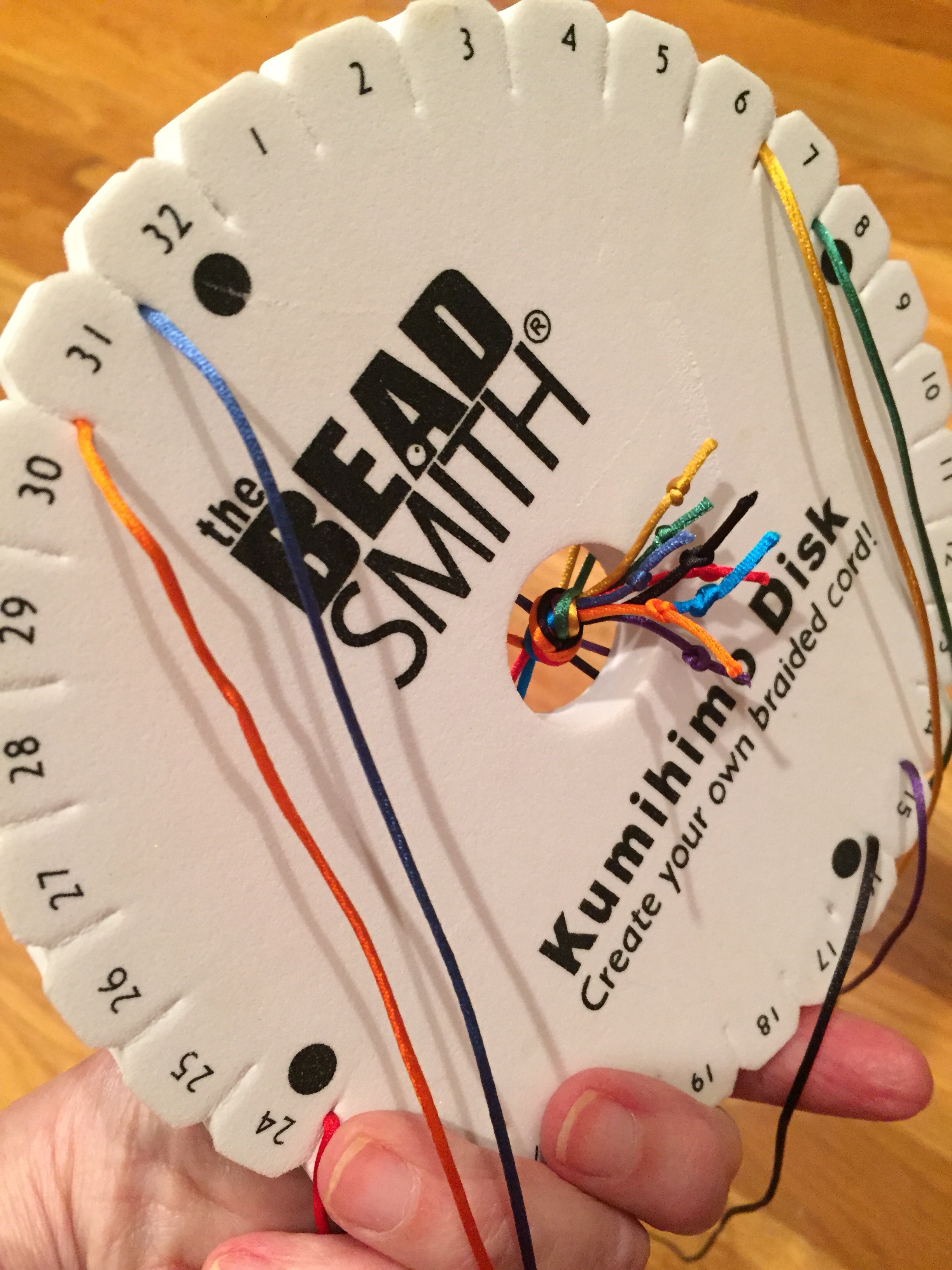
Now, what do you do with those 8 long tails? These bobbins, in my opinion, are the greatest thing since sliced bread! You will need 8.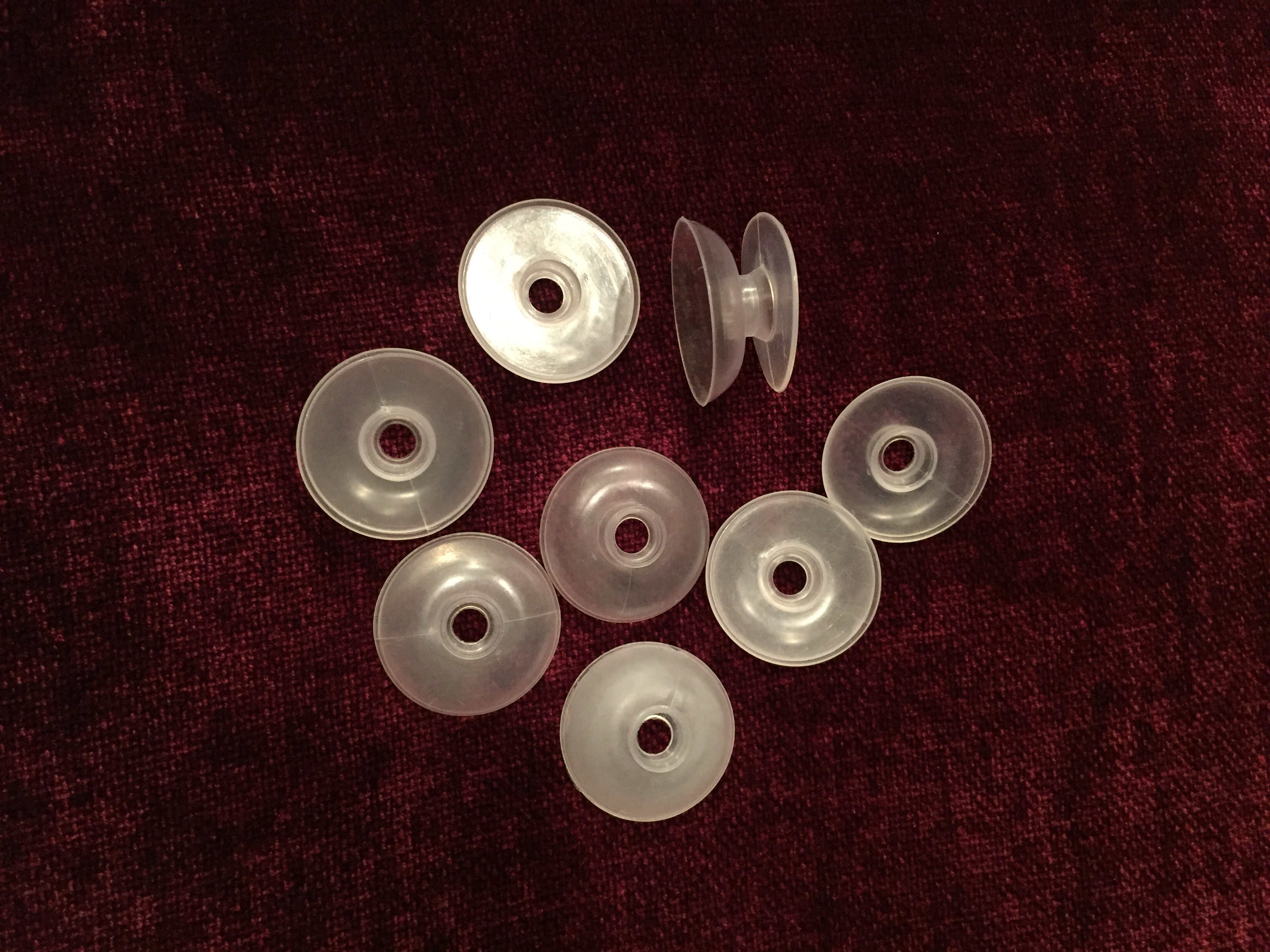 You can find them in craft stores or online. If you don’t have any, you can wind your excess cord around individual clothespins or even pieces of index cards.
You can find them in craft stores or online. If you don’t have any, you can wind your excess cord around individual clothespins or even pieces of index cards.
The bobbins pop open and closed. You can see an open one in the middle of the group below: Wrap each excess piece of cord around the center of an opened bobbin, leaving an inch or two unwrapped for working (braiding.) Snap them closed. These bobbins allow for cords to be pulled out as needed for the braid.
Wrap each excess piece of cord around the center of an opened bobbin, leaving an inch or two unwrapped for working (braiding.) Snap them closed. These bobbins allow for cords to be pulled out as needed for the braid.
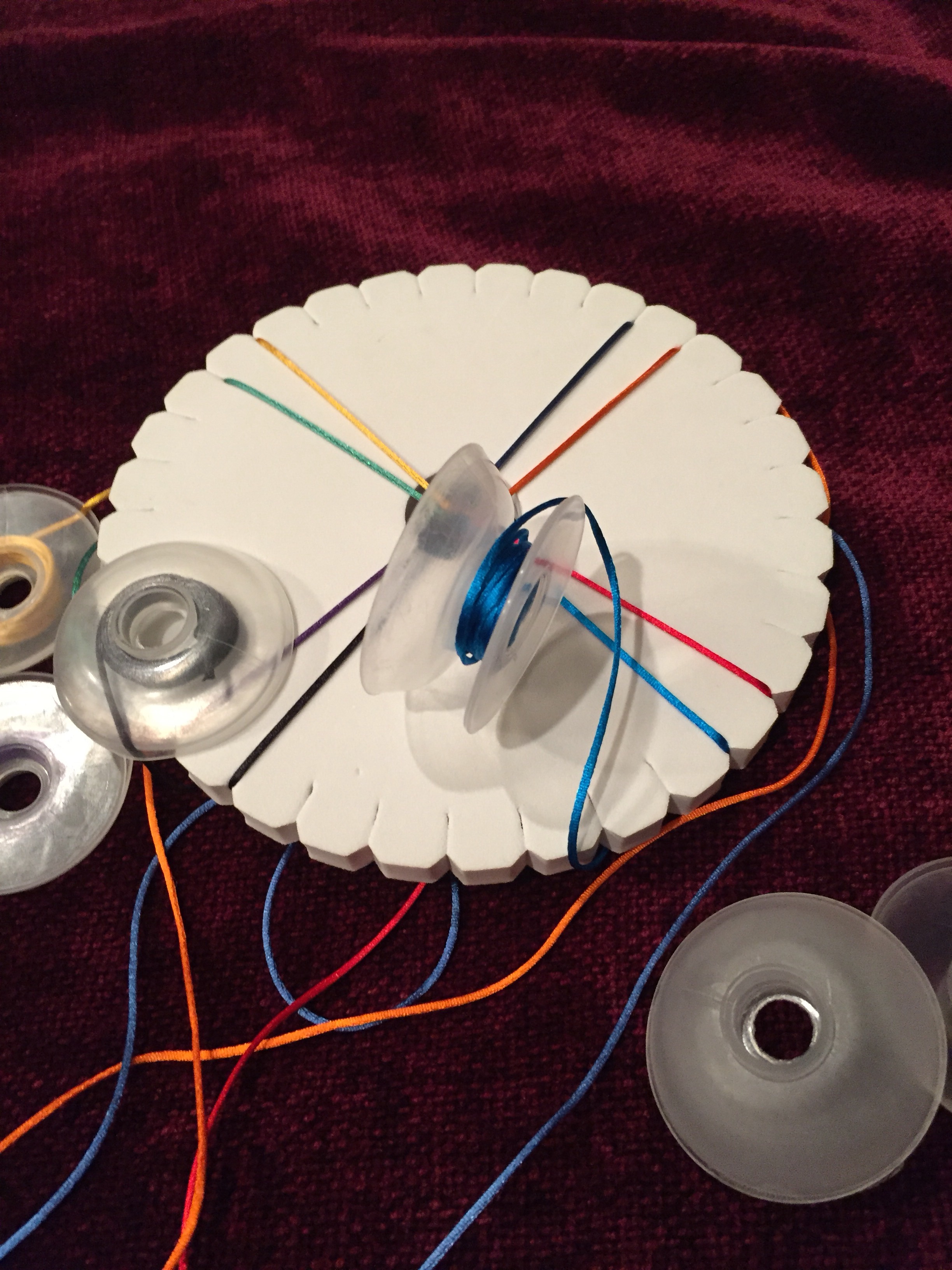
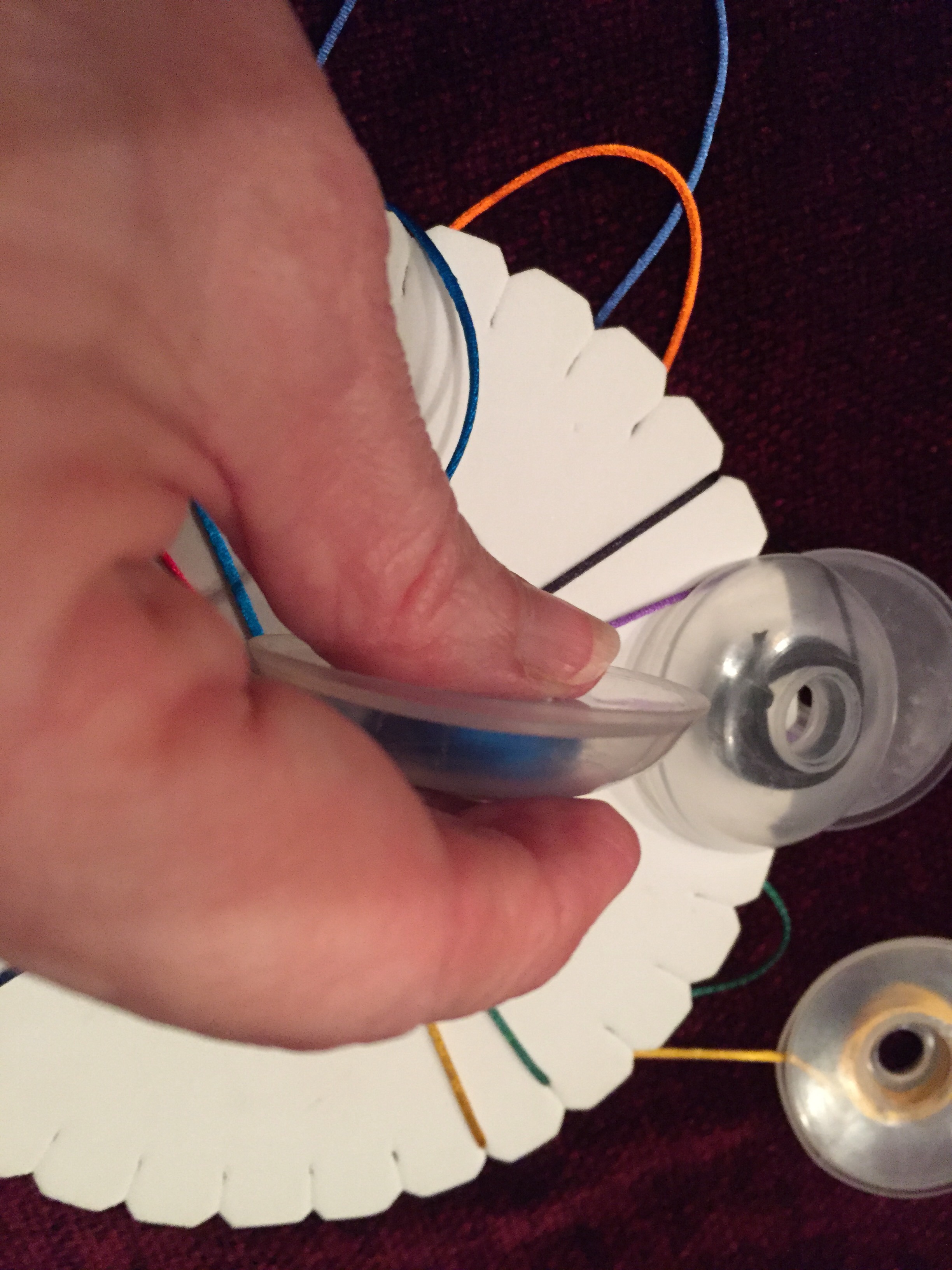
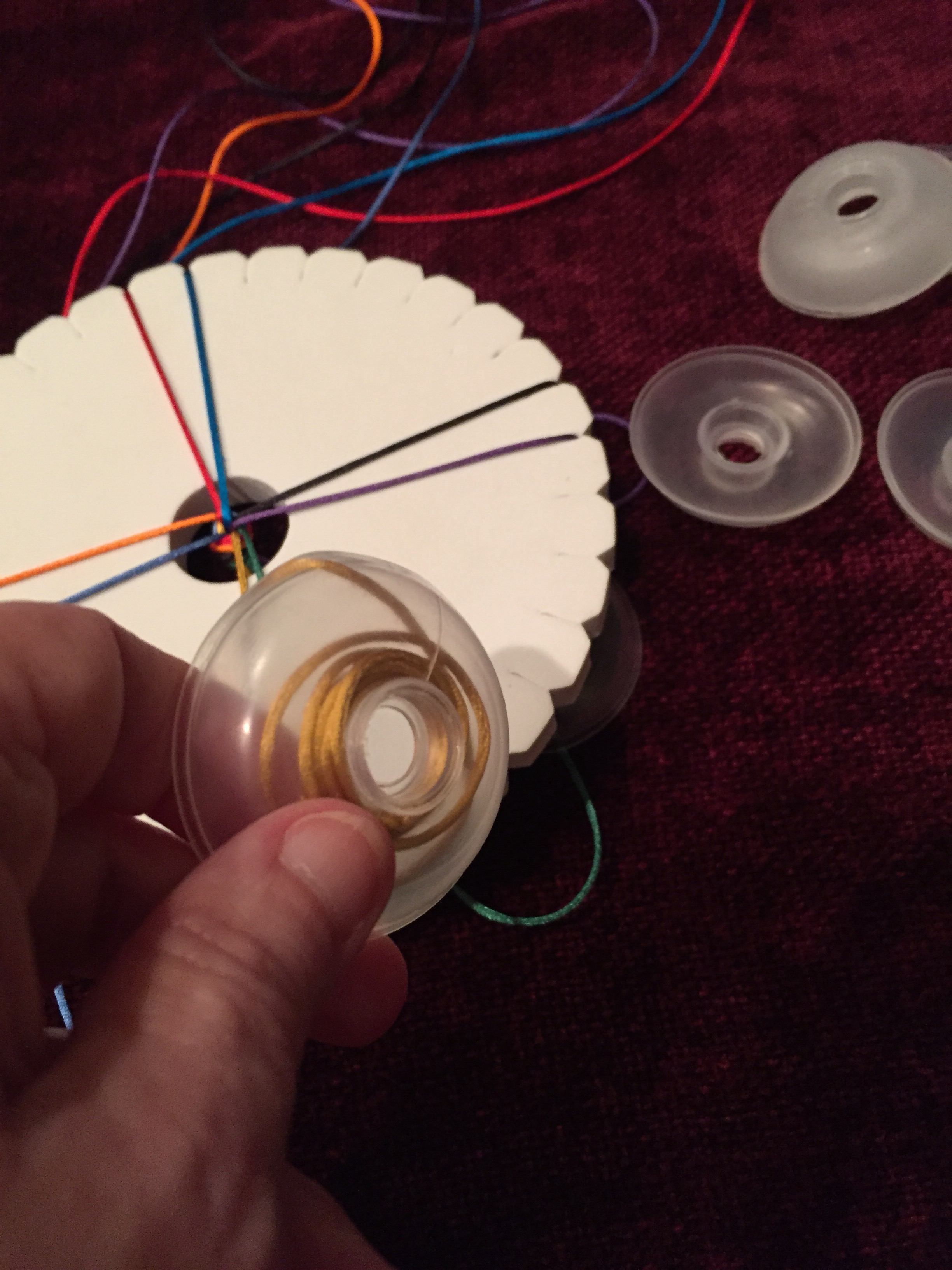
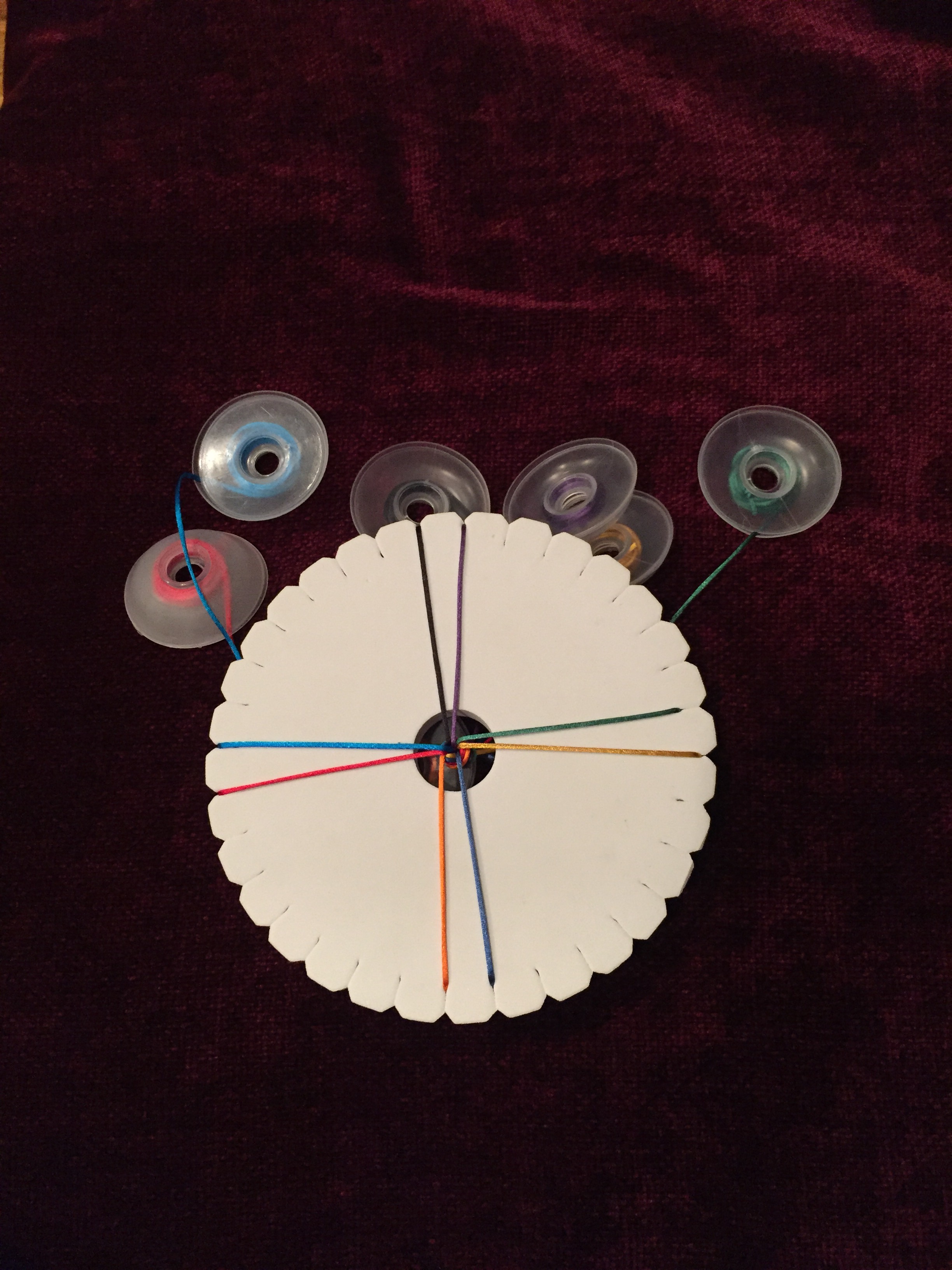
 Now, we’re ready to braid!
Now, we’re ready to braid!
Kumihimo on the porch…
Kumi Colors!
Playing with Jewelry
I got some itty bitty Czech glass button cabochons in the mail, today.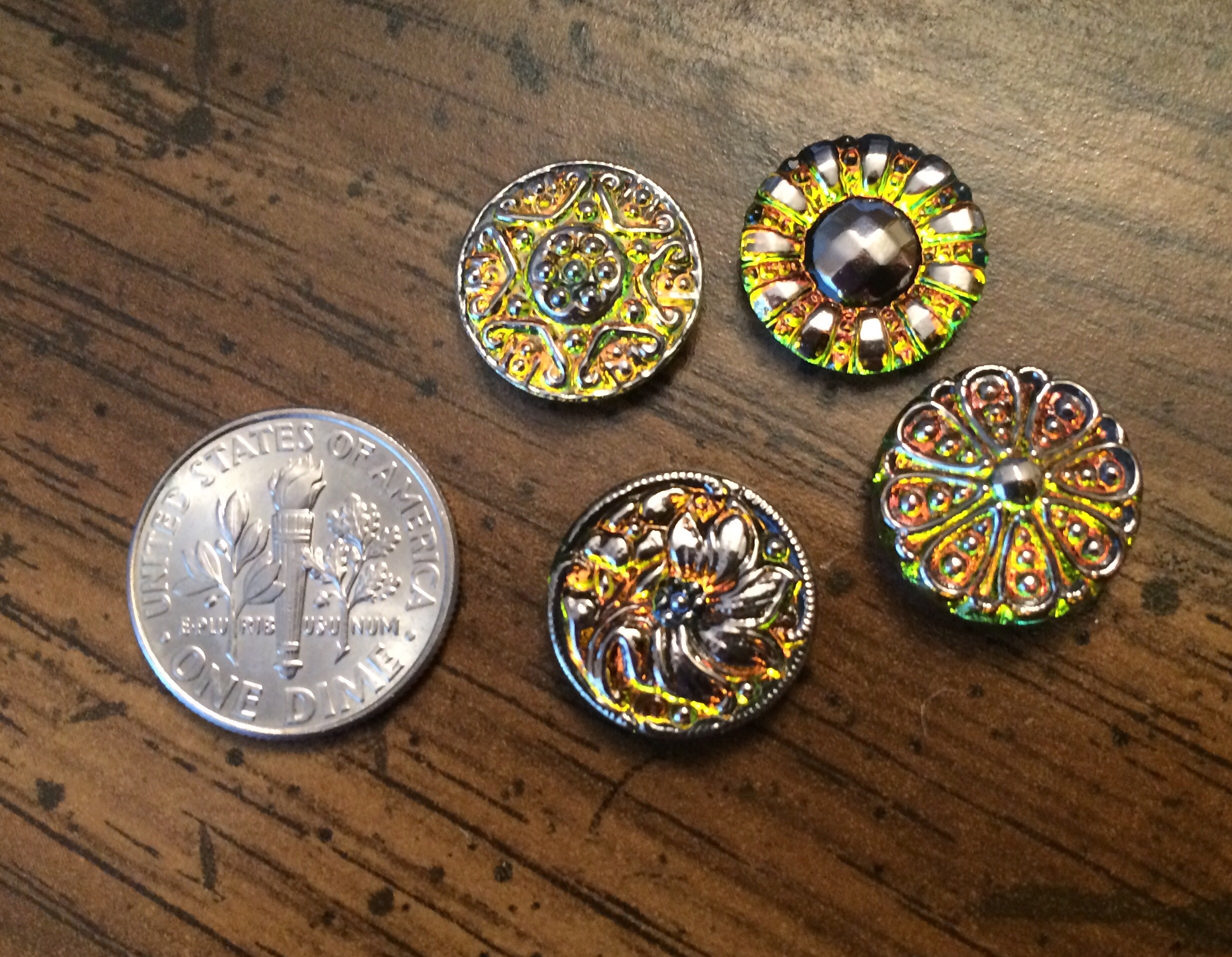 I tried them with some settings,
I tried them with some settings,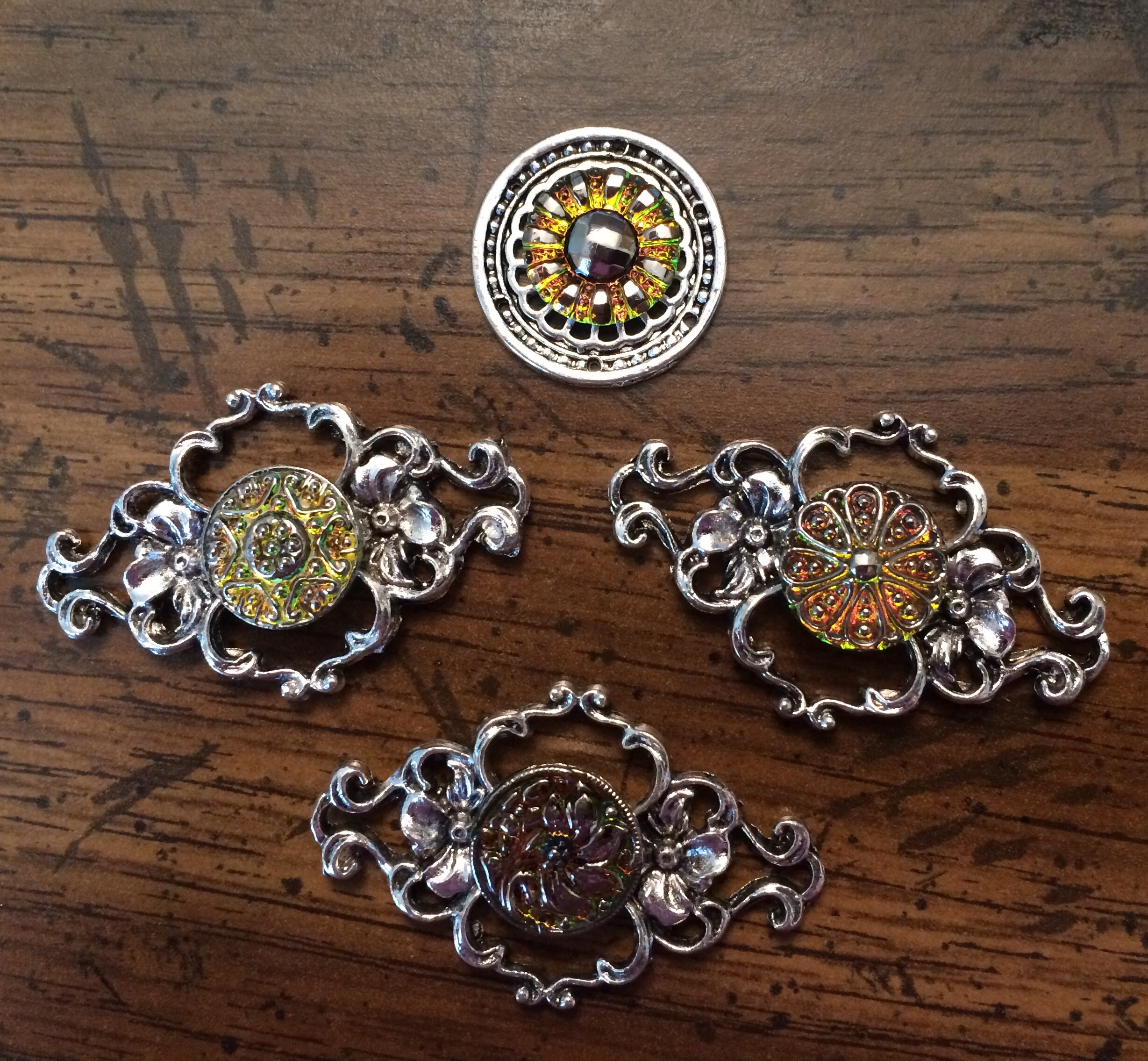 and I am pretty pleased.
and I am pretty pleased.
I finished a couple of necklaces. One is a diffuser/locket. Because it is a fairly heavy piece, I hung it from a heavy chain. I finished it with one of my favorite antique looking toggle clasps.
Because it is a fairly heavy piece, I hung it from a heavy chain. I finished it with one of my favorite antique looking toggle clasps.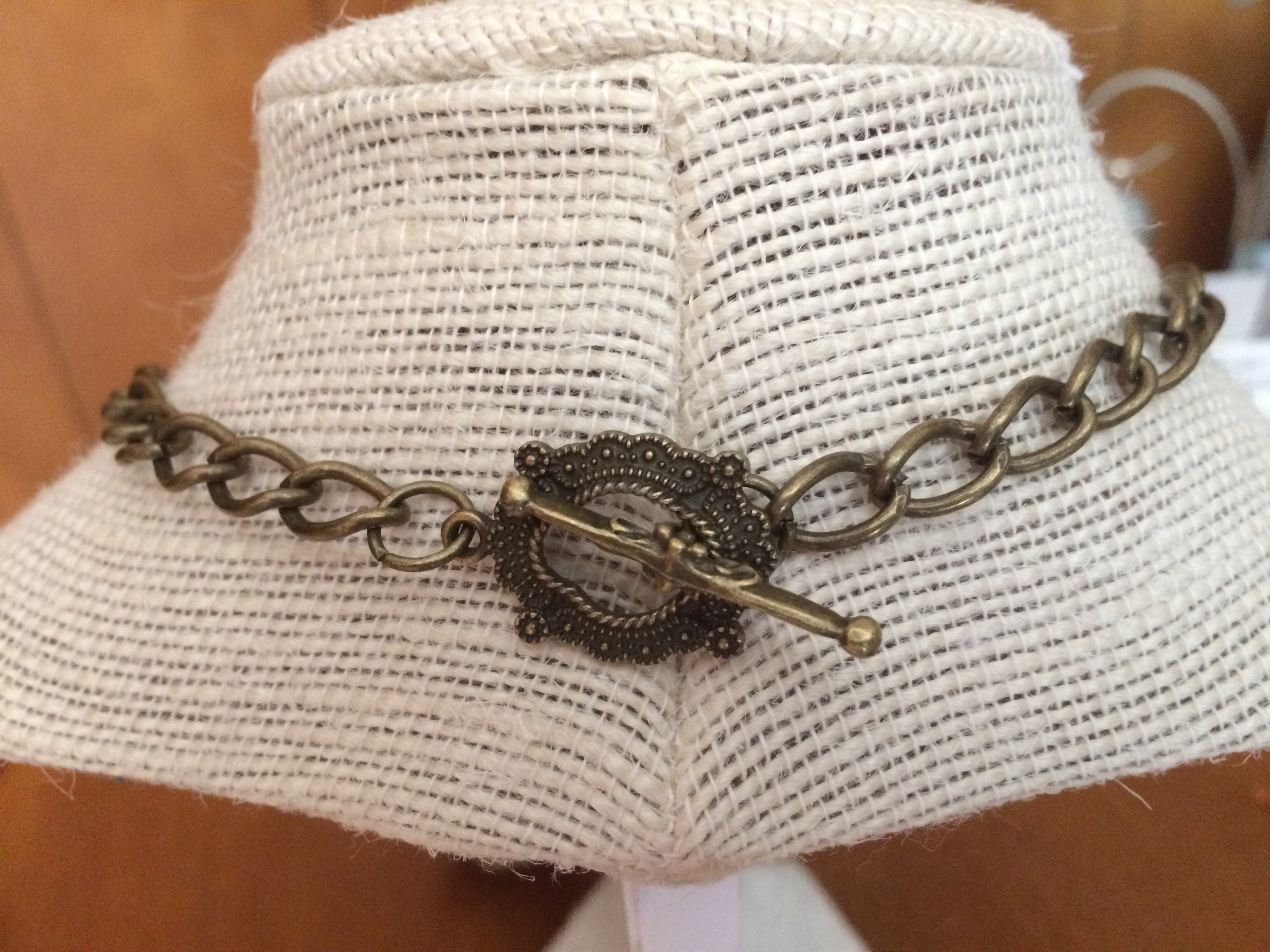 The other has a piece of Asian fabric captured under glass in a bamboo frame.
The other has a piece of Asian fabric captured under glass in a bamboo frame.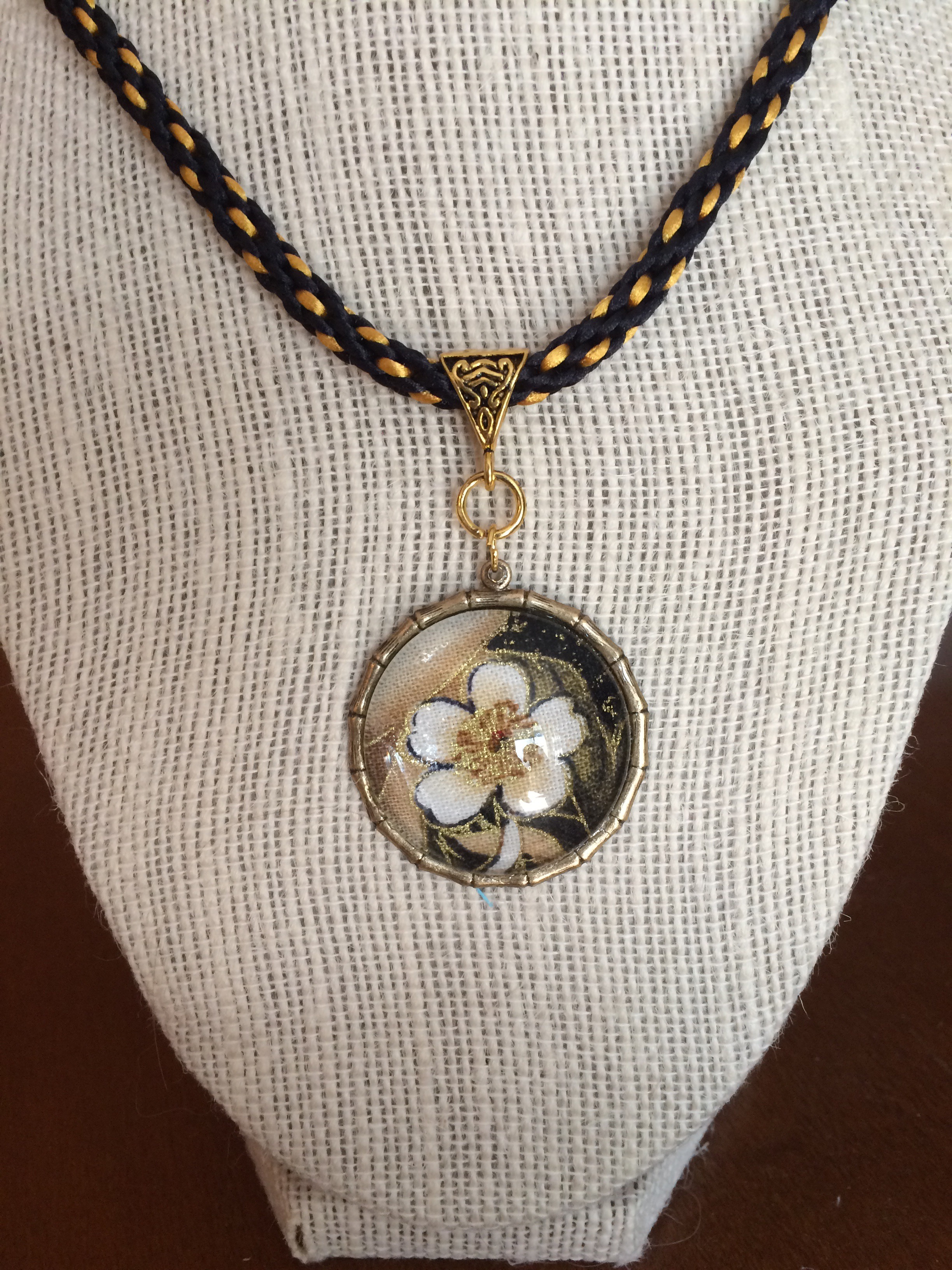 I wove a black and gold Kumihimo cord to match and finished it with a magnetic clasp.
I wove a black and gold Kumihimo cord to match and finished it with a magnetic clasp.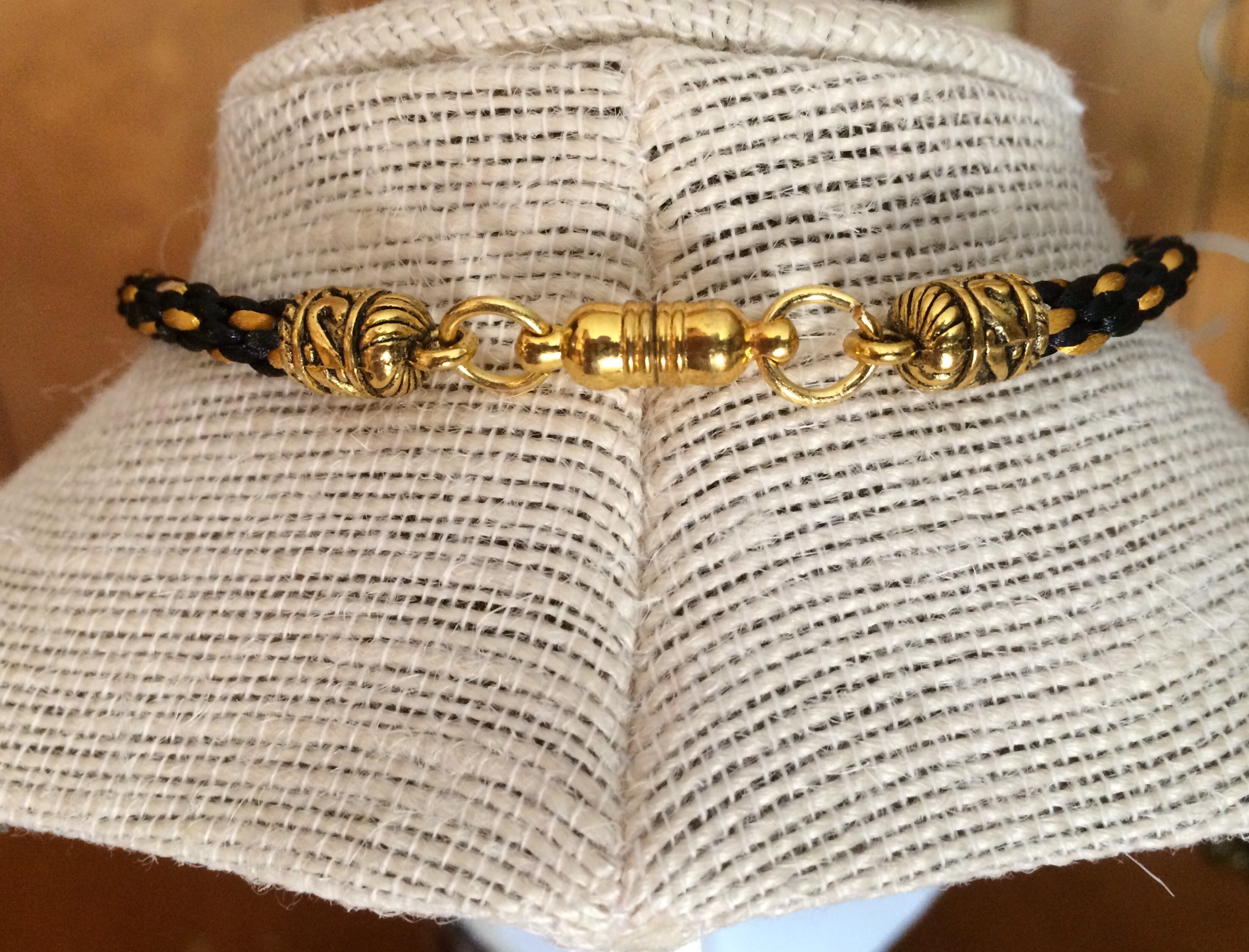
Fidget Spinners?
I’m Knot Crazy!!! (My mother had me tested!)
Well, yes, I admit it. I don’t do macramé, but I love knots. Celtic, Chinese, Nautical! 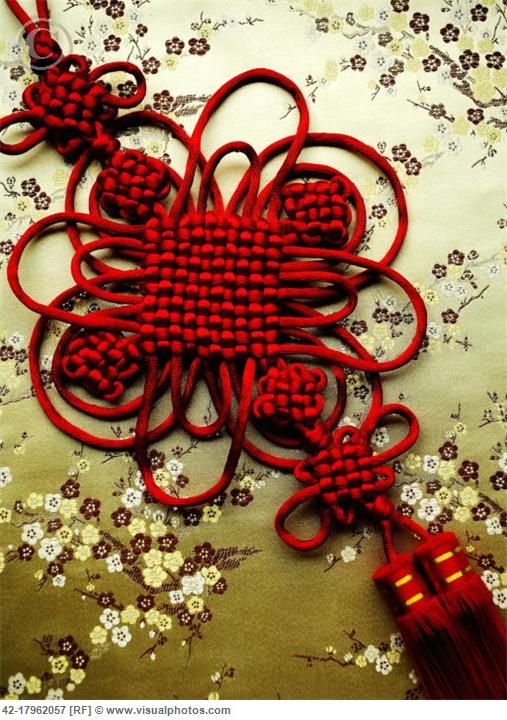 Here’s an extreme example of Chinese knotting that I’ll probably never achieve. I do want to learn some simpler knots, especially to make with my kumihimo cords. I started a new Pinterest board, today, “Lots of Knots.” Come visit!
Here’s an extreme example of Chinese knotting that I’ll probably never achieve. I do want to learn some simpler knots, especially to make with my kumihimo cords. I started a new Pinterest board, today, “Lots of Knots.” Come visit!
Kumihimo Lessons
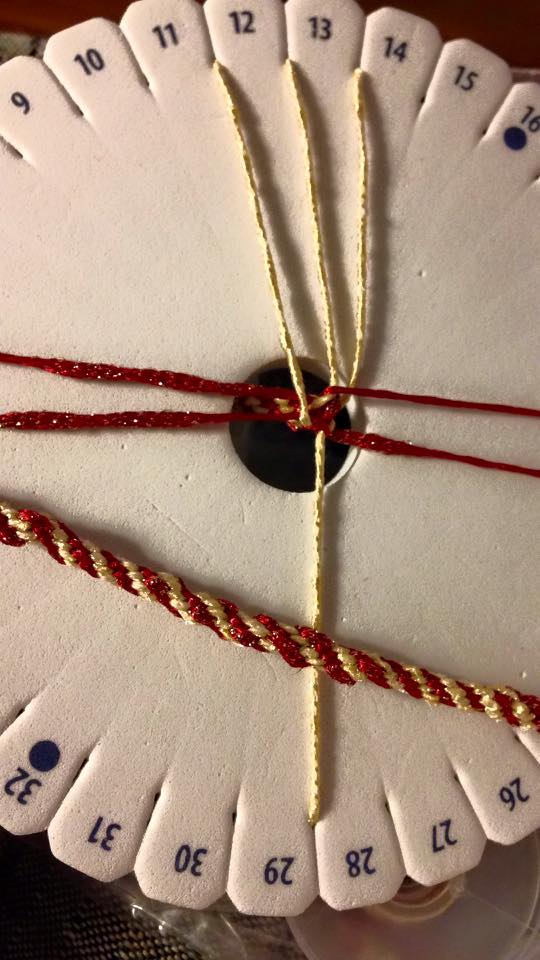 First of all, I thought these cords would be beautiful together. One is red shot through with a little metallic gold thread. The other is a light gold with just a little sheen.
First of all, I thought these cords would be beautiful together. One is red shot through with a little metallic gold thread. The other is a light gold with just a little sheen.
I was wrong. The light gold looks sand or camel colored in the twist.
Because the red is unevenly woven, the cord is, too.
I had hoped to make a bracelet out of it, but it looks like it’s fated for a gift tie. 
On the other hand, these yarns made a beautiful cord.
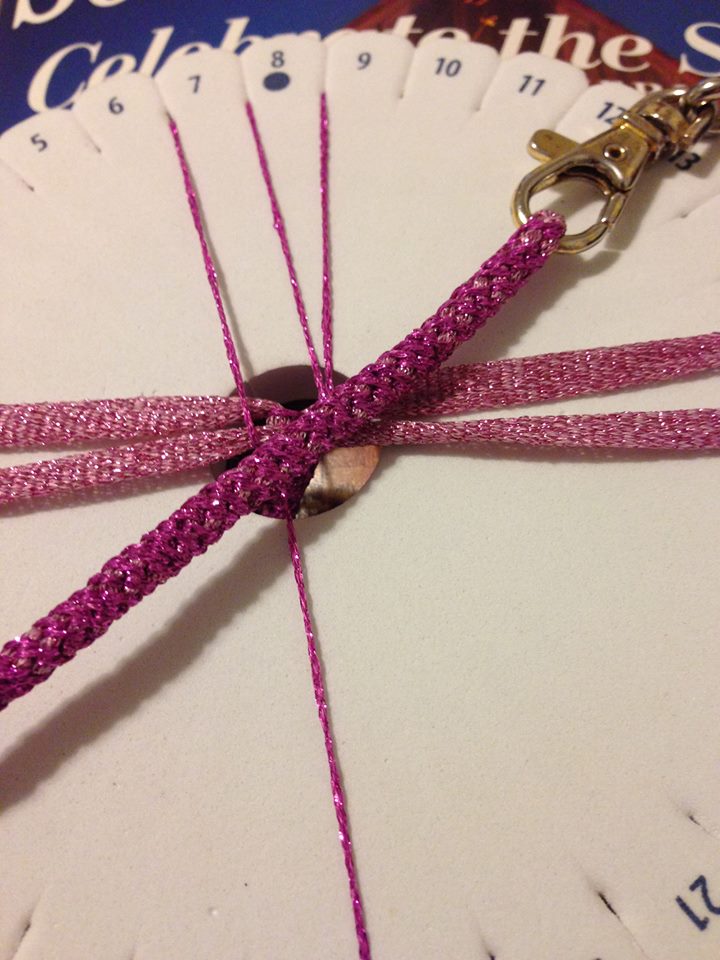
Here’s what I learned from this one: It’s an 8 strand cord of course, using 4 thick and 4 thin, placed perpendicularly to each other. (+) I began braiding with the thin cords and so they wrapped themselves around the thick ones. I started with 9 feet of each, but quickly used up the thin cords. Next time, the thin cords need to be at least 2 feet longer than the thick.
The resulting cord is beautiful, but all the metal content makes it scratchy. I won’t be using it in jewelry, either.
I Sold a Necklace!!!
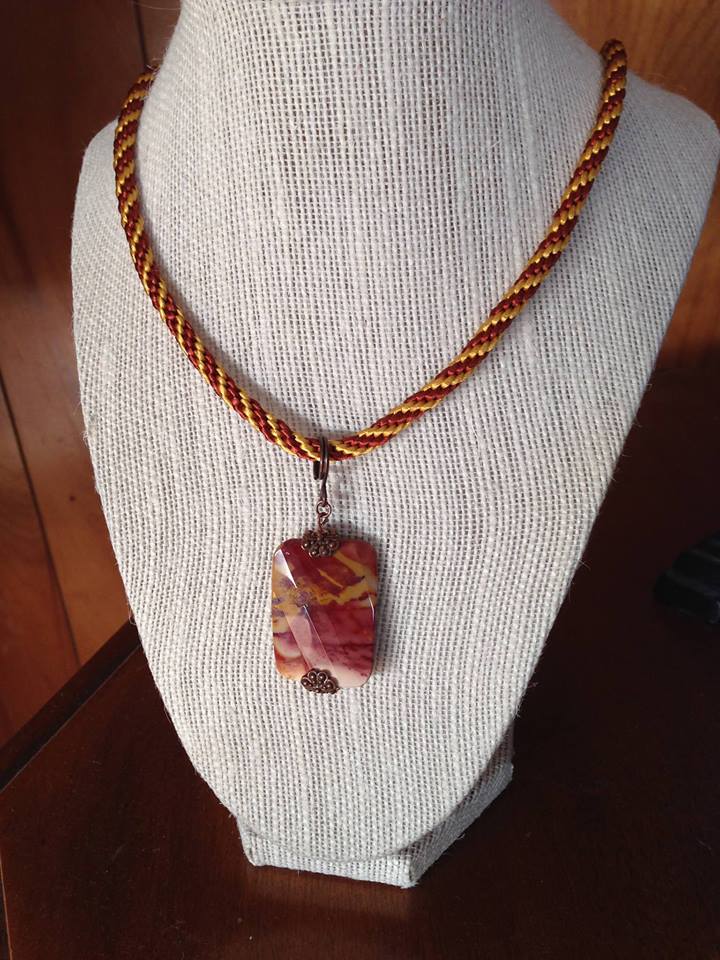
and the person who bought it actually came to pick it up and paid me!!! (I have three pieces that are waiting for their future owners!)
This is Mookaite from Australia, just like the burgundy piece I have for sale at the Wildflowers Shop in Elkin. Mookaite can be burgundy, pink, rust, gold, white or a combination of any or all of those colors! This piece is mainly rust and gold, so I wove a Kumihimo braid of rust and gold satin cord. I’d hoped to finish it in the fall, but had to find just the right antique copper findings!

